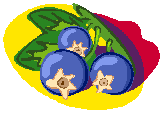

Welcome to
Blueberry Chef
- Recipes for Blueberries.
 |
|
Welcome to |
|---|
|
Blueberry History By Dr. Linda Posh The mighty blueberry belongs to the genus Vaccinium and is a Native American species. The blueberry is one of the few fruits native to North America. So diverse and hardy, the blueberry has a “cousin” that grows on the side of Hawaiian volcanoes. For centuries, blueberries were gathered from the forests and the ravines by Native Americans and eaten fresh or preserved. Blueberries were revered by Northeast Native American tribes and so valued that folklore was woven around them. The blosson end of each berry, called the calyx, forms the shape of a perfect 5 point star. Tribal elders would tell tales of these “stared berries” and how the Great Spirit offered them in order to keep children fed during times of famine. Portions of the blueberry plant were also used as medicine. Tea made from the plant was thought to be healthy for the blood. Blueberry juice was used to comfort coughs. The juice served a dual purpose and was used as a dye for cloth and baskets. Dried blueberries were added to stews and soups and the crushed dried powder was rubbed onto meats to offer them flavor. Blueberries as medicine? Well, that goes without saying. Settlers arrived in the New World during the 17th century and with their arrival came the clearing of land for farms. The climate in North America was not anything like the weather early settlers were accustomed to, so their early attempts at farming failed. Plymouth Rock, established in the year 1620, was one of the first Early American Colonies. Life wasn't easy and many suffered and died during this period. Those who survived went on to establish homes and farms. Their Native American neighbors pitched in and taught them new skills so the settlers might survive. They were schooled in the art of planting corn and taught how to gather native plants in order to augment their food supply. Of course, one of the most important crops was the mighty blueberry. Colonists learned from Native Americans how to gather, dry and store this most revered and delicious fruit. A drink made from blueberries was an important staple for soldiers during the civil war. As industrialization began taking over, the first blueberry canning facility was opened in the northeastern USA. For decades, the mighty blueberry maintained popularity as a major and thriving commercial business in the USA and Canada. At the turn of the century, the blueberry industry geared itself to an even more important step. In the early 1900's, Elizabeth White and Frederick Coville set out to domesticate the wild highbush blueberry. This laid the foundation for today’s cultivated blueberry industry. The early breeding work accomplished by these early pioneers gave rise to the blueberry we know today. Without these early pioneering efforts, we would not have the fresh and frozen blueberries in the grocery that we have come to know and love today. For decades, plant scientists have worked to enhance and identify the desirable characteristics of the Highbush Blueberry (the variety that is widely consumed today) and this has led to the cultivation of superior blueberries all the way around. The berries have been improved through natural selection and specialized plant breeding protocols. Today, we produce the optimal blueberry with marked color, flavor and texture for the fresh and processed food markets. The United States and Canada are responsible for producing 90 percent of the world's blueberry supplies. North American harvest season runs from mid April through the first part of October. Peak harvest is the month of July rendering it no surprise that July has been dubbed “National Blueberry Month”. Highbush blueberries are perennial, deciduous, long-lived and woody shrub like plants. They belong to the same family as cranberries and azalia. Blueberries thrive in acidic soil. Cultivated blueberries take anywhere from 120 to 160 days to mature. Flowering in the spring, blueberry plants bear fruit anywhere from 60 to 90 days afterwards. Today, the modern Highbush blueberry is grown commercially in 38 states and Canadian Provinces. Highbush blueberry industries have also cropped up in places such as Australia, South America, Europe and New Zealand. The USA and Canada are the biggest producers and consumers. However, the market around the world is on the rise with Japan in the forefront, it appears. Overall, fresh market and processed market blueberries demand and consumption is on the rise. At this point in time, it would be almost safe to say that everyone loves blueberries. While scientific research constantly takes place with regard to the marked health benefits surrounding this little fruit, the majority simply eat them without the blink of an eye. Because we are able to can and freeze these delicious amazing little fruits, one can find blueberries available year round. Regarded as a good thing as research has proven beyond a doubt why everybody should be enjoying this powerful little gift from nature.
Dr. Linda Posh MS SLP ND. "Doc Posh" brings a fresh perspective to natural health and nutrition. She packs a solid educational background with degrees in organic chemistry, psychology and a Masters in Communication Sciences and Disorders. The Dr. sports a diverse work history including experience and expertise in acute care neurorehab services, special education, autism support services, spinal cord injuries, senior rehabilitation services and currently consults to both patients and colleagues in natural health. Recently, she has been in the laboratory, formulating revolutionary whole food nutritional supplements. Nutra-Resources Body Balance Liquid Vitamins Website donates all profits to providing free Health Care for those in need. Sign up for Doc Posh’s newsletter. Get the latest in health care discoveries, consumer deception and more. Visit http://www.Nutra-Resources.com for the finest in liquid vitamins. Article Source: http://EzineArticles.com/?expert=Dr._Linda_Posh |
|
|---|

Custom Search
|
Contact Us Copyright 2010 ©Linda C Butler PO Box 92, Chilliwack BC V2P 6H7 All Rights Reserved Internationally Legal Notice and Privacy Policy |
|---|